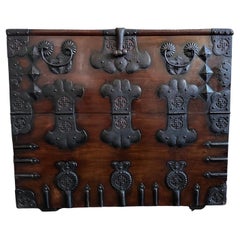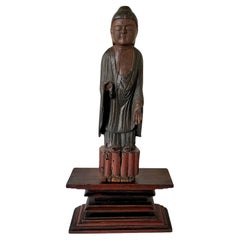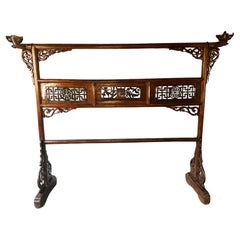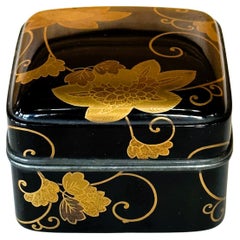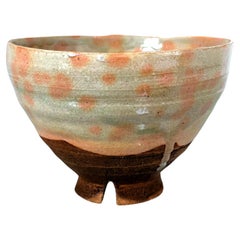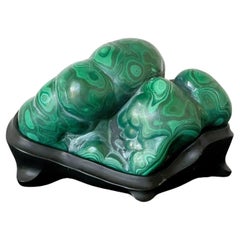TISHU Asian Art and Furniture
to
9
734
690
41
3
58
9
2
1
130
311
249
44
138
44
24
22
4
9
9
9
6
2
1
2
4
284
244
151
109
100
693
648
346
152
140
734
734
734
27
15
11
10
6
Antique Korean Bandaji from Jeju Island
Located in Atlanta, GA
An antique Korean Bandaji from Jeju Do (Jeju Island) circa 19th century. Made from hardwood planks (possibly pine or pearwood) and stained in a dark color...
Category
Antique 19th Century Korean Other Furniture
Materials
Iron
Antique Japanese Carved Village Buddha Enku Style
Located in Atlanta, GA
A carved wood buddha with lacquered surface in the style of Erku (1632–1695), a monk from Edo period who was famous for hand-carving Buddha statues in a primitive style. From a single wood block of what appears to be cedar, the standing buddha was carved in an unpolished manner with exposed knife strokes that effectively depicted a subtly smiling face and the folding of the cascading robes. The rustic style is full of Mingei charm being a great example of Japanese Buddhism...
Category
Antique 18th Century Japanese Edo Sculptures and Carvings
Materials
Wood
Large Antique Chinese Carved Wood Robe Display Rack
Located in Atlanta, GA
A large garment robe display rack from Northern China, circa late 19th century toward the end of Qing Dynasty Made of elm wood and finished in a deep...
Category
Antique Late 19th Century Chinese Qing Furniture
Materials
Wood
Antique Japanese Lacquered Incense Box Kobako in Kodaiji Style
Located in Atlanta, GA
An antique lacquered small box that was likely used to contain incense powder (it is called Kobako in Japanese), circa early to mid-19th century of the Edo...
Category
Antique 19th Century Japanese Edo Lacquer
Materials
Wood, Lacquer
Japanese Glazed Ceramic Gohon Chawan Tea Bowl
Located in Atlanta, GA
A bespoken Japanese ceramic glazed tea bowl with fabric insert, pouch and original padded wood tomobako box. The chawan has a slightly irregular wall supported by a high notched foot...
Category
Antique 19th Century Japanese Meiji Ceramics
Materials
Ceramic
Malachite Rock on Display Stand as a Chinese Scholar Stone
Located in Atlanta, GA
Displayed on a black custom carved wood stand, this solid malachite rock specimen with intense green and black colors functions as a Chinese scholar stone. The gemstone showcases the...
Category
20th Century American Chinoiserie Natural Specimens
Materials
Stone
Japanese Art Deco Ikat Silk Meisen Kimono
Located in Atlanta, GA
A striking and well preserved Japanese Meisen kimono hand-sewn from woven Ikat Silk circa 1920-40s (Taisho to Showa period). The kosode style kimono (sma...
Category
Early 20th Century Japanese Showa Textiles
Materials
Silk
Vintage Woven Ikat Chapan Robe Central Asia Uzbekistan
Located in Atlanta, GA
Chapan is the iconic fornt-open flowing robe traditionally worn by the nomadic people in Central Asia. In countries like Uzbekistan, it was almost the old national costume. This Uzbe...
Category
Mid-20th Century Uzbek Tribal Textiles
Materials
Cotton
Japanese Maki-e Lacquer Tray Box with Cutout Design
Located in Atlanta, GA
A Japanese lacquer box with lid and an inner tray decorated with Maki-e on a dense nashiji background. The fine box was likely made circa 1920-30s...
Category
Vintage 1920s Japanese Taisho Lacquer
Materials
Wood, Lacquer
Ikat and Embroidery Textile Panel from Sumatra Indonesia
Located in Atlanta, GA
An Indonesia textile panel professionally presented on a linen canvas. It can be taken off from the canvas for easy and economical shipping upon req...
Category
20th Century Indonesian Tribal Textiles
Materials
Cotton
Korean Folding Chaekgeori Painted Scholar Floor Screen
Located in Atlanta, GA
A six-panel painted folding floor screen from Korea circa early 20th century. This type of screen is called Chaekgeori (books and things) which is quite unique to Korea. It became popular at the end of 18th century favored and encouraged by King Jeongjo (1752-1800) as a political tool to promote social conservatism such as the traditional Confucianism value, especially considered important in a time when waves of new ideology influx came to Korea. Initially commissioned for the royal court, they became increasingly popular with the scholars of noble and affluent households and were used widely in their halls and studies. Early screens were painted with trompe-l’oeil bookcases displaying books and arrays of collectibles. Later, the bookcases were eliminated to focus on the assemblage of neatly stacked books and objects of scholarly pursue. On this screen, the six panels were neatly presented and framed in woven brocade borders. Among the stacked volumes, one can find many fine porcelain vases with flowers, potted orchids, pen holders with brush pens and scroll paintings, incense burner, ink stone, teapot, fan with ink painting, vessels of fruits, exotic plants such as lotus, plumeria and even a pair of glasses. It feels like a pleasant visual measure hunting for the viewers. Several words in Chinese found their way into the picture as well, including filial (xiao), longevity (shou) and luck (fu).
The painting was done in a meticulous way with no details overlooked and also with a rather western still-life dimensional perspective. In a rather unusual maximal but also minimalistic way, the screen exudes a historical charm with a folky flair but appears modern at the same time.
Each panel is 17.5"w by 70.2"h.
For general information on the subject see reference: Chaekgeori the Power and Pleasure of Possessions in Korean Painted Screens...
Category
20th Century Korean Folk Art Paintings and Screens
Materials
Brocade, Silk, Wood, Paper
Japanese Contemporary Bamboo Basket by Abe Motoshi
By Abe Motoshi
Located in Atlanta, GA
A Japanese Ikebana basket woven by bamboo artist Abe Motoshi (Japanese, b. 1942). In an organic vase form with elegant, curved wall with reinfo...
Category
Late 20th Century Japanese Modern Scholar's Objects
Materials
Bamboo, Rattan
Korean Antique Bronze Footed Vessel with Lid Early Joseon Dynasty
Located in Atlanta, GA
A bronze bowl shape vessel with fitted lid from Korean dated to 15-16th century (early Joseon Dynasty). In an elegant minimalistic form with thin wall and supported by a high foot ri...
Category
Antique 16th Century Korean Other Metalwork
Materials
Bronze
Japanese Porcelain Vase Makuzu Kozan Meiji Period
By Makuzu Kozan
Located in Atlanta, GA
A striking blue and white vase from the studio of Japanese Potter Makuzu Kozan, also known as Miyagawa Kozan (1842–1916), one of the most established and collected ceramist from Meiji Period. Born as Miyagawa Toranosuke, Kozan established his pottery studio in Yokohama circa 1870s and later became one of the appointed artists to the Japanese Imperial household. His work was exhibited in many international fairs that the Meiji government participated at the turn of the century and won many grand prizes.
Of a relatively large size, this vase is decorated with underglaze cobalt blue using the novel technique developed by Kozan called Fuki-e (the blow painting). As a result, the bamboos appear took on a three-dimensional quality as if appearing in a mist. Known as one of the most creative ceramists, circa 1887, Kozan started experimenting with new chemical colors from the West in the format of his porcelain glaze. New colors allowed him to create underglaze design that appeared bright, smooth and glossy. He even invented his own receipt of cobalt blue to achieve a much brighter yet softer shade, as evident on this vase. To create landscape that is realistic and dimensional, more common in the western paintings, he was inspired by the native Japanese ink painting technique developed around 1900 by Yokoyama Taikan...
Category
Antique Early 1900s Japanese Japonisme Ceramics
Materials
Ceramic
